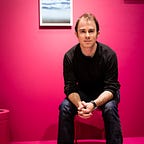The Gods of Belief
This essay is the third in a series documenting lessons learned from my time at Electric Objects. Follow me on Medium to find out when the next essay is published.
In The New New Thing, Michael Lewis follows Jim Clark in the late 90’s through the creation of three multi-billion dollar businesses. Clark’s process looked like this: he dreamed of a new world in which the company he was building lived at the center — “a state of pure possibility.” In exchange for a part of that dream, venture capitalists gave Clark some money. The money attracted more money. And eventually that bigger chunk of money helped make the dream a reality.
This is the story of venture capital when it works: belief turns into capital which turns into reality.
The problem with belief is that it’s a lot more fickle and unpredictable than profit. I can tell you what profitability looks like. Basic math doesn’t change from one month to the next. What looks attractive to the venture community, however, certainly does. Choose your path carefully. I chose belief.
The team at Bolt wrote a great post about the hardware startup “valley of death.” That moment after you’ve shipped your first generation product, when your business is too risky to get an affordable lender to finance your production, your absolute unit numbers are too low to be exciting for VCs, and you haven’t figured out scalable acquisition mechanics. You’re funding your entire business — people, production, and marketing — on belief. It is all too familiar to me, and to many of my fellow hardware founders.
Here’s how it went down: We didn’t raise the capital we needed, to fund the kind of growth that we needed, in order to raise the kind of money that we needed, so that we could build a business that fundamentally worked. We designed the Electric Objects business in such a way that, for those four years, we lived (and eventually died) on belief.
Tactically, this meant keeping prices and margins artificially low (versus finding buyers at the right price), rushing into retail relationships (versus focusing on the more profitable channels first), building a second generation product (versus finding buyers for the first), prematurely designing our manufacturing and supply chain for scale (versus keeping fixed costs to a minimum while we discover that scale), and over-spending in a variety of other ways to stimulate a perception of top-line momentum.
If you find yourself organizing your business around what you think the next crop of investors want to see, rather than what’s good for the business, you’re handing your business over to the gods of belief. The good news is that the inverse is also true: the more profit you have, the less belief you need.
I’m not saying I will never again seek out venture capital. I think I’m happiest when I’m building products and businesses that demand belief, and venture is an asset class designed to fund belief. What I am saying is that I’d like to need belief a little less the next time around.
And I won’t go so far as to say we couldn’t have made the company work with the capital we raised. A good way to measure the amount of capital raised is to count the number of mistakes you can afford. At Electric Objects it’s not so much that we didn’t raise enough money, we just made more mistakes than we had money to recover from.
We all want the exceptional outcome, but that doesn’t mean we should design our businesses so that they can only be successful as such. Organize your business around the pursuit of profit, and the believers will come.
